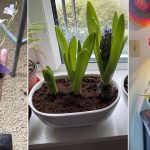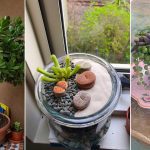Have you noticed tiny moving dust specks? They are Little White Bugs that Look like Lint or Dust and can harm your home and garden!
If you’ve ever seen Little White Bugs that Look like Lint or Dust on plants or other surfaces, you might have wondered what they are. These small insects are often hard to spot until there are many of them. Although they may not seem important, their presence can be indicative of a major infestation and hence require prompt action. We have listed those alarming insects that’ll help you spot them quickly and take the necessary measures to ward them off your home!
Little White Bugs that Look like Lint or Dust
1. Thrips

Thrips are slender, tiny insects with fringed wings that appear as small, moving specks of dust on plant surfaces. They feed by puncturing plant cells and sucking out the contents, causing silvery streaks or stippling on leaves. These bugs can affect a wide range of plants and may also transmit plant viruses.
2. White Plant Hoppers

White plant hoppers secrete a white, waxy substance that gives them the appearance of tiny pieces of cotton or fluffy white dust on the plant’s stems and leaves. These bugs produce sticky honeydew, which attracts ants, further promoting the growth of black sooty mold.
3. Spider Mites
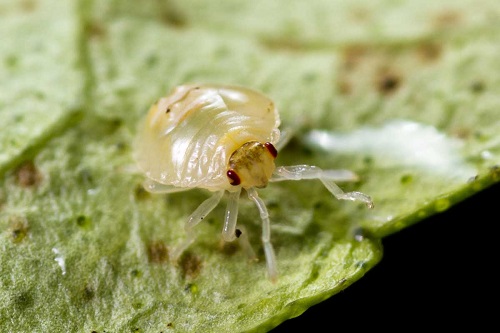
Spider mites are not insects but rather tiny arachnids that can infest plants, particularly under hot and dry conditions. They appear as tiny dots or specks on leaves and may produce webbing, resembling small patches of dust or lint.
4. Springtails

These tiny, wingless insects have a soft, elongated body and a hunched appearance, resembling tiny flecks of dust or bits of lint. Springtails get their name from their ability to jump when disturbed. While they are harmless to humans and generally don’t cause significant damage to plants, they can become a nuisance when present in large numbers.
5. White Grubs
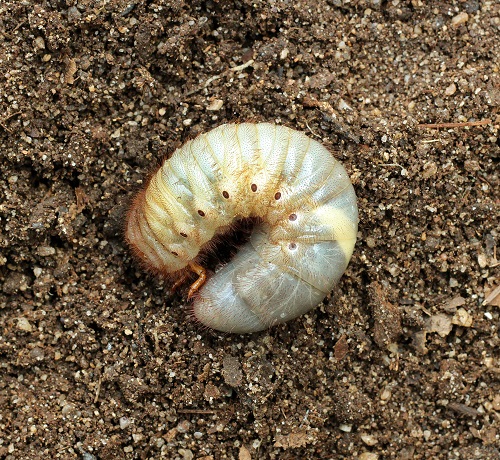
These grub larvae have a soft, creamy-white body and a c-shaped appearance. While they may not resemble lint or dust directly, their presence in the soil can lead to yellowing or wilting of plants, making them noticeable. White grubs feed on plant roots, causing damage to the root system and potentially killing the affected plants.
6. Whiteflies
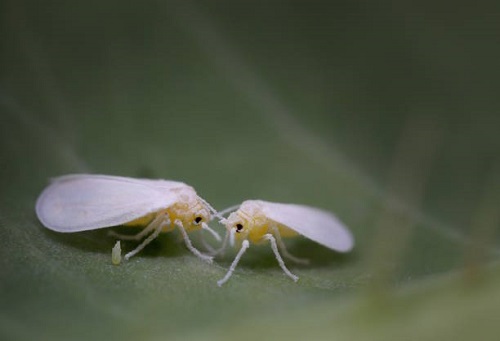
Whiteflies are small, winged insects that are commonly found on the undersides of plant leaves. They resemble tiny flakes of white dust or lint either in flight or at rest. These pests feed on plant sap and excrete sticky honeydew, which can lead to the growth of black sooty mold.
7. Scale Insects
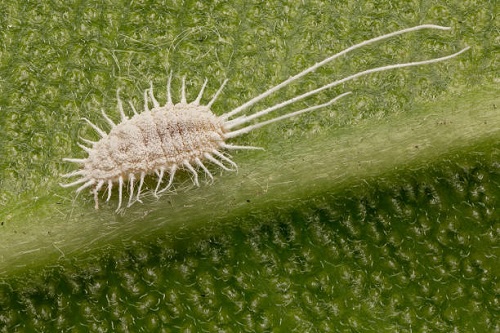
Small, oval-shaped Scale Insects often mimic dust specks or lint bumps on plants. A protective waxy layer gives them a powdery appearance. By attaching themselves to stems, leaves, or branches, they can weaken plants and stunt their growth.
8. Psyllids

Often mistaken for dust specks due to their size, Psyllids are tiny insects that typically range from 1 to 5 millimeters in length. Their powdery texture helps them easily hide between the leaves and axils of plants, leading to yellowing, wilting, and even death of the plant in severe infestations.
9. Plaster Bagworm
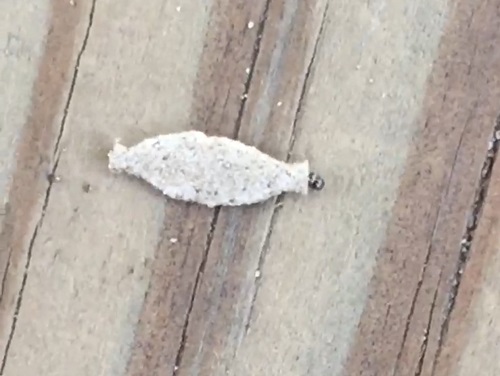
Plaster Bagworms, commonly found in homes, are pretty difficult to spot, especially on white walls. Though they pose no threat to humans, a large number of these creatures can indicate high humidity levels and an alarm for the building structure.
10. Soil Mites

Soil Mites are tiny creatures resembling dust particles or lint. Found in damp environments, they feed on mold spores and organic matter, pointing to underlying moisture issues or mold infestations.
11. Mealybugs

These soft-bodied insects covered in a powdery, waxy substance often disguise as dust in hidden areas, such as leaf axils or plant crevices. Feeding on plant sap, they can distort leaves and cause plant decline if not controlled.
12. Aphids

Aphids are small, pear-shaped insects that come in various colors, including white, and they can resemble dust or lint when clustered on plant stems or leaves. These pests can cause distorted growth, curling leaves, and transmit viral diseases.
13. Mold Mites
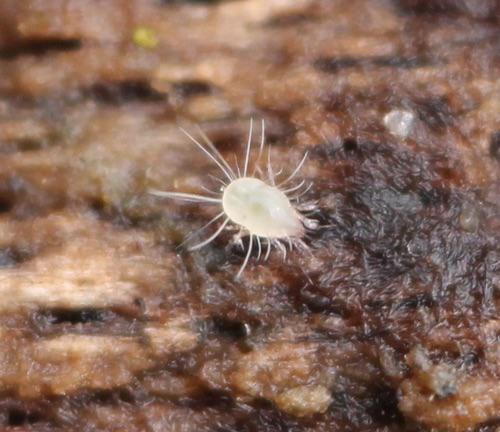
Mold mites are often found in damp, humid environments where mold and fungi thrive. Mold mites feed on mold spores and organic matter present in damp areas, such as decaying plant material or food. These Tiny White Bugs that Look Like Lint or Dust indicate potential moisture problems or mold infestations.
14. Psocids

Also known as booklice or barklice, these bugs are characterized by small, soft-body that resemble tiny particles of dust or lint. They are commonly found in basements, bathrooms, or storage areas. Psocids feed on mold, fungi, and organic matter.
15. Termites

Termites are small, pale bugs that look like dust or lint when seen in their swarmer (winged) form. These insects live in large colonies and primarily feed on wood and other cellulose-based materials. Known for their destructive capabilities, termites can cause severe structural damage to buildings and wooden structures.
16. Dust Mites
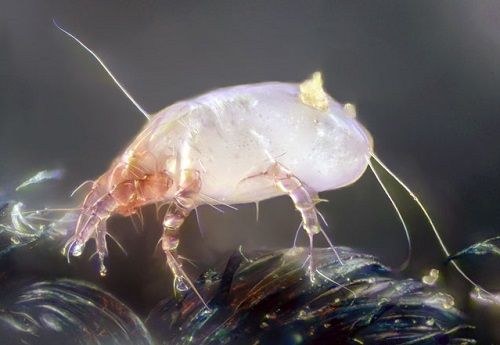
These are microscopic arachnids that are invisible to the naked eye but can easily hide in household dust due to their minute structure. They are commonly found in mattresses, upholstery, and carpeting and feed on dead skin cells, causing allergic reactions in humans.
17. Pot Worms

Pot worms, also known as enchytraeids, are small white worms that resemble fine threads or pieces of lint. They are often found in potted soil or garden beds. Beneficial to the environment, these bugs feed on decaying organic matter and help with decomposition.
18. Beech Scale
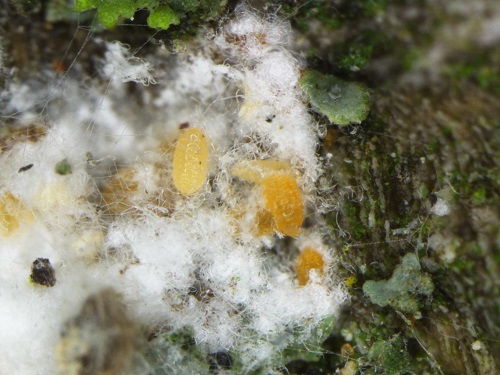
These insects are small, flat, and oval-shaped with a white or grayish appearance, resembling patches of dust or lint on the bark of beech trees. They feed on the sap of beech trees, causing yellowing, wilting, and dieback of foliage. Beech scale infestations can weaken trees and make them more susceptible to other pests and diseases.
19. Cottony Cushion Scale

These small, oval-shaped insects produce a cottony, waxy substance that covers their bodies, resembling clumps of lint. They primarily infest woody plants and feed on their sap. Heavy infestations can cause leaf yellowing, wilting, and even plant death.
20. Clothes Moth Larvae

Not the insect, but its larvae appear as Little White Bugs that Look Like Lint or Dust with their cylindrical shape and a soft, fuzzy texture. Clothes moth larvae are commonly found in dark, undisturbed areas such as closets and drawers, where they feed on natural fibers like wool, fur, silk, or feathers, causing considerable damage if left untreated.
How to Remove Bugs from Your Home and Garden?
These Little White Bugs that Look Like Lint or Dust can be an absolute nuisance. If you already have a pest infestation and need to remove them, here are some steps you must follow:
- Clean and Declutter: Remove any clutter or unnecessary items that can provide hiding places for pests. Thoroughly clean the floors, countertops, and furniture to eliminate food sources and potential pest attractants. Eliminate access to food and water that might be attracting pests. Store food in sealed containers, fix any leaks or moisture issues and keep the kitchen and dining areas clean.
- Seal Entry Points: Close off entry points that pests may be using to enter your home. Seal any cracks, gaps, and holes on the walls using appropriate sealants or materials.
- Vacuum and Steam Clean: Vacuum the affected areas to remove pests, eggs, and debris. Steam clean or use hot water to treat areas that can withstand moisture to kill pests and their eggs.
- Use Pesticides: Consider using pesticides or insecticides as a last resort if the infestation is severe or persistent. Choose products labeled for the specific pest and follow the instructions carefully.
- Professional Pest Control: If the infestation is extensive or recurring, or if you’re dealing with a pest that requires specialized expertise, seek professional pest control services. They can assess the situation, employ effective treatments, and provide ongoing monitoring and prevention.
- Prevent Reinfestation: After successfully eliminating the pests, take preventive measures to avoid future infestations. Maintain a clean and hygienic environment, and address any underlying issues that may attract pests.





